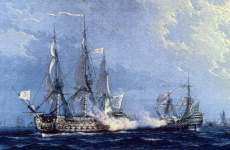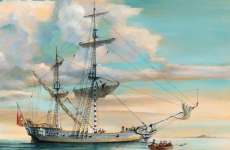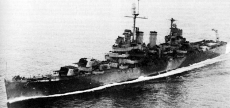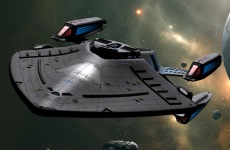History of the Phoenix
Created by Captain Ricardo (Rico) Montoya on 08 Oct 2018 @ 4:27pm
One Earth’s most renowned ancient mythological creatures was the Phoenix. For millennia the Phoenix was a symbol of strength, rebirth, and even immortality; said to be capable of carrying tremendous loads, striking fear into the impure, granting courage to the pure in heart, and overcoming death by embracing life. As mankind advanced it sought to endow various craft with these attributes by naming them after the Phoenix.

English ship Phoenix (1546) - A 20-gun ship purchased in 1546, rebuilt in 1558, and sold in 1573.

English ship Phoenix (1613) - A 20-gun ship launched in 1613 and in the records until 1624.

English ship Phoenix (1647) - A 38-gun ship launched in 1647, in Dutch hands for several months in 1652, and wrecked in 1664. Phoenix was a fourth rate frigate of the English Royal
Navy, as completed she was established with a peacetime 32 guns, but by 1652 carried 38 guns as a wartime establishment. She was enlarged during her life and by the 1660s was
measured at 556 tons.

English ship Phoenix (1665) - A Dutch ship captured in 1665 and sunk as a blockship in 1667.

HMS Phoenix (1671) - A 42-gun fifth rate launched in 1671. She was upgraded to a 42-gun fourth-rate in 1674, but reverted to a 36-gun fifth rate in 1691. She was burnt in 1692 to
prevent her capture.

HMS Phoenix (1692) - An 8-gun bomb vessel purchased in 1692 and sold in 1698.

HMS Phoenix (1694) - An 8-gun fire ship launched in 1694, rebuilt in 1709 as a 24-gun sixth-rate and rebuilt again in 1727. She was hulked in 1742 and sold in 1744. HMS Phoenix was
originally built as a fireship. In 1707, as a part of Admiral Sir Cloudesley Shovell's fleet, she saw action during the unsuccessful Battle of Toulon. Was present during the great naval disaster off the Isles of Scilly when Shovell and four of his ships Association, Firebrand, Romney and Eagle) were lost, claiming the lives of nearly 2,000 sailors. Phoenix ran ashore between Tresco and St Martin's and had to be beached, but could be kept seaworthy and finally managed to reach Portsmouth. In 1709, the former fireship was re-built as a 20-gun sixth-rate frigate. When under the command of Vincent Pearse, she sailed to Nassau, Bahamas in February 1718, to offer the king's pardon to pirates who were willing to surrender and abandon piracy. She also played a minor role in the 1740 Siege of St. Augustine during the War of Jenkins' Ear. In 1741, under the command of Captain Fanshaw, she was involved in the defense of Charlestown, South Carolina from Spanish pirates.

HMS Phoenix (1743) - A 24-gun post ship launched in 1743, used as a hospital hulk after 1755, and was sold in 1762.

HMS Phoenix (1759) - The HMS Phoenix was a 44-gun fifth rate Ship of the Royal Navy. She saw service during the American War of Independence under Captain Hyde Parker, Jr. She, along with HMS Rose and three smaller ships launched an attack on New York City on 12 July 1776. During that attack, Phoenix and the other ships easily passed patriot defenses and bombarded urban New York for two hours. This action largely confirmed continental fears that British naval superiority would allow the Royal Navy to act with relative impunity when attacking deep-water ports.
HMS Phoenix was also involved in a kind of currency war. During the Revolutionary War, when the Continental Congress authorized the printing of paper currency called continental currency, the monthly inflation rate reached a peak of 47 percent in November 1779. One cause of the inflation was counterfeiting by the British, who ran a press on HMS Phoenix, moored in New York Harbor. The counterfeits were advertised and sold almost for the price of the paper they were printed on. The Phoenix was lost in a hurricane off Cuba in October of 1780.

HMS Phoenix (1783) - The HMS Phoenix was a 36-gun Perseverance-class fifth-rate frigate of the Royal Navy, launched on 15 July 1783. She served in the French Revolutionary and
Napoleonic Wars and was instrumental in the events leading up to the battle of Trafalgar. Phoenix was involved in several single-ship actions, the most notable occurring on 10 August 1805 when she captured the French frigate Didon, which was more heavily armed than her. She was wrecked, without loss of life, during a storm off Smyrna in 1816.

HMS Phoenix (1832) - The HMS Phoenix was a 6-gun steam paddle vessel of the Royal Navy, built in a dry dock at Chatham in 1832. She was reclassified as a second-class paddle sloop before being rebuilt as a 10-gun screw sloop in 1844-45. She was fitted as an Arctic storeship in 1851 and sold for breaking in 1864.

USS Phoenix (1841) - The second USS Phoenix of the American Navy, was a 2-gun schooner that served in the United States Navy from 1841 to 1853, seeing service in the Second Seminole War and the Mexican War. Following her construction the Phoenix arrived at Norfolk, Virginia on 18 October 1842. During the following two years she made three voyages to Panama. From 1846 to 1850, she served in the Gulf of Mexico conducting hydrographic surveys and providing general support to U.S. naval operations during the Mexican War and the peace which followed. Phoenix returned to the United States East Coast in 1851 and served in the Atlantic Ocean until sold in 1853.

USCS Phoenix (1845) - A schooner that served as a survey ship in the United States Coast Survey from 1845 to 1857.

USS Phoenix (1861) - The Phoenix was a 404-ton American wooden whaler based in New London, Connecticut. The Union Navy purchased Phoenix at New London on 9 November 1861, at the start of the American Civil War. The Navy wanted her for the Stone Fleet, a group of vessels to be sunk in the channels of important Southern harbors to interrupt Confederate trade. She sailed on the 20th but grounded while crossing Savannah Bar, lost her rudder, and began leaking badly. When refloated she was beached as a breakwater to shelter Union troops landing on Tybee Island, Georgia, on or before 5 December 1861, in preparation for the Battle of Fort Pulaski.

HMS Phoenix (1879) - A composite Dotterel-class screw sloop launched in 1879 and sent to the North America and West Indies Station. Sloops of her type were designed for patrolling Britain's extensive maritime empire, and were normally sent to foreign stations for extended periods. Typically the crews would serve commissions of several years before handing their ship over to a newly arrived crew and returning home in another ship. She was wrecked on the east point of Prince Edward Island, Canada, in 1882, with no loss of life.

HMS Phoenix (1895) – The HMS Phoenix was a Royal Navy Phoenix-class steel screw sloop. She was launched at Devonport in 1895, saw action in China during the Boxer Rebellion, and later served on the Pacific Station. She had the misfortune to be alongside a coaling pier in Hong Kong on 18 September 1906 when a typhoon struck the colony. She foundered and became a total loss.

HMS Phoenix (1911), an Acheron-class destroyer launched in 1911 and sunk 1918 by the Austro-Hungarian submarine SM U-27. Capable of 28 knots (52 km/h), she carried two 4-inch (102 mm) guns, other smaller guns and 21 inch (533 mm) torpedo tubes and had a complement of 72 men. At the beginning of the First World War, Phoenix was part of the First Destroyer Flotilla operating in the North Sea. She and her sisters were attached to the Grand Fleet as soon as the war started. On 16 August 1914, within days of the outbreak of war, the First Destroyer Flotilla engaged an enemy cruiser off the mouth of the Elbe. She was present with the First Destroyer Flotilla on 28 August 1914 at the Battle of Heligoland Bight, led by the light cruiser Fearless. On 24 January 1915 Phoenix took part in the Battle of Dogger Bank, and her crew shared in the Prize Money for the German armored cruiser Blücher. Phoenix was escorting the Australian troopship Ballarat when the Ballarat was attacked by a German submarine on 25 April 1917 in the English Channel. Although efforts were made to tow Ballarat to shallow water, she sank off The Lizard the following morning. No lives were lost of the 1,752 souls on board, a striking testament to the calmness and discipline of the troops. On May 14th 1918, while patrolling the Otranto Barrage, the Phoenix was torpedoed amidships by an Austro-Hungarian submarine.

HMS Phoenix N96 (1929) – The HMS Phoenix was a Parthian-class submarine of the Royal Navy, launched in 1929. She was the eighteenth warship of the Royal Navy to use the name Phoenix and served on the China Station from her commissioning until the start of the Second World War. Phoenix was then relocated to the Mediterranean Sea and was sunk by the Italian torpedo boat Albatross on 16 July 1940.

USS Phoenix CL-46 (1938) - A light cruiser of the Brooklyn-class cruiser family. She was the third Phoenix of the United States Navy. She toured the west coast of the United States with port of call in Santa Cruz and San Francisco, California, Portland, Oregon, and points in between. Transferred to her new home port of Pearl Harbor, Hawaii in 1940, the Phoenix continued to operate off the West Coast of America. On 7 December 1941 during the attack on Pearl Harbor she was anchored north east of Ford Island near Solace. The Phoenix escaped the disaster unharmed and shortly after noon was underway to join two cruisers and several destroyers in an impromptu task force searching, unsuccessfully, for the enemy aircraft carriers. During World War II the Phoenix served as an escort, as well as participating in several operations in the pacific theater, having been awarded a Bronze and 11 Silver Battle Stars. The Phoenix was enroute to Pearl Harbor for overhaul when Japan capitulated. She headed home and, upon reaching the Panama Canal on 6 September, joined the Atlantic Fleet. She was eventually decommissioned and sold in 1946.

USNS Phoenix T-AG-172 (1962) - A Phoenix-class miscellaneous auxiliary acquired by the United States Navy in 1962, crewed by a civilian crew from the Military Sea Transportation Service, and sent to the Philippines to serve as a floating depot. Phoenix remained in the Philippines, issuing parts and other supplies, until the early 1970s, being struck by the Navy in 1973.

USS Phoenix SSN-702 (1979) - A Los Angeles-class nuclear submarine, was the fifth ship of the United States Navy to be named "Phoenix". This USS Phoenix not only set a speed record for circumnavigating the Earth but received numerous peacetime awards: 3 Meritorious Commendations, 3 awards for Tactical Excellence, 2 awards for Antisubmarine Warfare Excellence, and awards for Excellence for Operational, Communications, Damage Control, and Weapons Proficiency. She was decommissioned 1998.

Phoenix Lander (2008) - a robotic spacecraft on a space exploration mission on Mars under the Mars Scout Program. The Phoenix lander descended on Mars on May 25, 2008. Mission scientists used instruments aboard the lander to search for environments suitable for microbial life on Mars, and to research the history of water there. Phoenix was NASA's sixth successful landing out of seven attempts and was the first successful landing in a Martian polar region. The lander completed its mission in August 2008, and made a last brief communication with Earth on November 2 as available solar power dropped with the Martian winter. The mission was declared concluded on November 10, 2008, after engineers were unable to re-contact the craft.

Phoenix 2063 – Built by Zefram Cochrane, the Phoenix was an Earth spaceship launched in the 21st century. It was the first Earth’s first manned spacecraft to achieve faster-than-light speeds using warp drive. The Phoenix is remembered as the ship that instigated Earth's first contact with an alien race. Constructed from a nuclear missile, the first stage of the craft used traditional chemical engines. First-stage shutdown and separation was performed in orbit. Following separation, nacelles were extended, the warp core and plasma injectors were brought on-line, and the nacelles were charged. It took several seconds to accelerate to critical velocity were warp speed was then achieved by the craft. The first flight of the Phoenix attracted the attention of a passing Vulcan ship, the T'Plana-Hath, causing the Vulcans to decide to make First Contact.

USS Phoenix NCC-65420 (2363) – The USS Phoenix was constructed at the Starfleet ship at 40 Eridani, and was commissioned on Stardate 40250.5 For a time the name of the Phoenix was tarnished when the ship, under the command of Captain Ben Maxwell, it was involved in a lone wolf incursion into Cardassian space when Captain Maxwell suspected the Cardassians of rearming. Captain Maxwell was confronted by the Captain Picard of the USS Enterprise and relieved of his command.
Following the outbreak of the Dominion war the USS Phoenix was assigned to the Seventh Fleet. The Phoenix was eventually destroyed by the Jem’Hadar in the Tyra System.

USS Phoenix NCC-65420-A (2394) – True to its namesake the next ship to carry the name Phoenix has risen form the ashes of its predecessor. This particular ship was constructed at the fleet yards at Deep Space 5 and commissioned on Stardate 71939.7. The latest ship to carry the name Phoenix is a state of the art Prometheus Class Starship. In addition to being capable of Multi Vector Assault Mode (MVAM), the separating of the ship into 3 independently warp-capable vessels, this USS Phoenix can also maintain warp 9.99 for prolonged periods due to it's advanced warp core.
While the Prometheus Class is primarily a scout/combat vessel, this ship is also equipped with a cloaking device, ship wide holo-emitters, holographic interface systems & holo-monitors as well as standard multi-function, adaptable touch screen consoles, one of the most advanced computers in Starfleet, and all the comforts of home.
What the future holds for the newest ship to bare the name Phoenix is still unknown.
Categories: Phoenix Information | The Federation